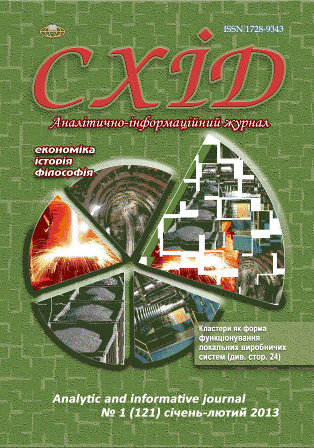Designing of the efficient motivation system of the staff professional development
DOI:
https://doi.org/10.21847/1728-9343.2013.1(121).13416Keywords:
motivation, professional development, Management Company, staff, diagnosis, principles of motivation, efficiencyAbstract
There were the theoretical questions of motivation and staff development analyzed. The system of scientific principles of motivation for company's professional staff development was substantiated. Stages of development and implementation of effective motivation for professional staff development were proposed. Motivators and tools for three groups of management personnel of the Managing Company were structured, for which there were the appropriate methods of motivation defined. Individual approach based on personality traits which influence the motivation of professional development: age/sex, marital status, and outlook, was suggested to use. Demotivating problems of staff regarding professional training were identified and the ways of overcoming those problems were proposed. Universal system of measures for motivation for professional staff development was developed.
Downloads
References
Шлендер П. Э. Управление персоналом / П. Э. Шлендер. - М. : ЮНИТИ-ДАНА, 2005. - 320 с.
Егошин А. П. Управление персоналом / А. П. Егошин. - 3-е изд. - Н.Новгород : НИМБ, 2001. -716 с.
Маслова В. М. Управление персоналом предприятия / В. М. Маслова. - М. : ЮНИТИ, 2007. - 159 с.
Herzberg F. One ore time: How do you motivate employees? / F. Herzberg // Harvard Busines Reviev. - 2003. - January. - Pр. 87-96.
Phillips J. J. Technology's Return on Investment / J. J. Phillips // Advances in Developing Human Resources. - 2002. - Vol. 4. - Рp. 512-532.
Joy-Matthews J. Human Resource Development / J. Joy-Matthews, D. Megginson, M. Surtees. - 3rd ed. - London, 2004. - 432 p.
Сваб Л. І. Мотиваційні аспекти відтворення, розвитку та використання трудового потенціалу вітчизняних підприємств / Л. І. Сваб // Бюлетень ЗСТУ. - 2010. - № 2 (52). - С. 303-306.
Богиня Д. П. Методологічні засади формування мотиваційного механизму конкурентоспроможності робочої сили / Д. П. Богиня // Мотиваційний механізм формування конкурентоспроможності робочої сили : зб. наук. праць. - К. : Ін-т економіки НАН України, 2002. - С. 10-27.
Железнякова Т. А. Краткая методика развития деловой карьеры работника [Електронний ресурс]. - Режим доступу : http://www.jourclub.ru/27/1065/.
Продіус О. І. Мотивація трудової діяльності персоналу промислових підприємств в умовах глобалізації економіки [Електронний ресурс]. - Режим доступу : http://www.nbuv. gov.ua/portal/soc_gum/znpchdtu/2009_22_1/articles/Problem_ upravleniya/22_Prodius.pdf.
Shlender P. E. (2005), Human resource management, Moscow, 320 p. (rus).
Egoshyn A. P. (2001), Human resource management, 3rd ed., NIMB, N. Novgorod, 716 p. (rus).
Maslova V. М. (2007), Human resource management enterprise, YUNITI, Moscow, 159 p. (rus).
Herzberg F. (2003), Harvard Busines Reviev, January, рр. 87-96.
Phillips J. J. (2002), Advances in Developing Human Resources; Vol. 4, pp. 512-532.
Joy-Matthews J., Megginson D. & Surtees M. (2004), Human Resource Development, 3rd ed., London, 432 p.
Svab L. I. (2010), Bulletin ZSTU; 2 (52). pp. 303-306.
Bohynia D. P. (2002), Motivational mechanisms of competitive workforce: Proc. Sciences. Proceedings, Institute of Economics of NAS of Ukraine, Kyiv, pp.10-27.
Zheleznyakova T. A. (2011), Quick method of business career employee, available at: http://www.jourclub.ru/27/1065/.
Prodius O. I. Motivation employment of personnel of industrial enterprises in a globalized economy, available at: www.nbuv.gov.ua.
Downloads
Published
How to Cite
Issue
Section
License
Copyright (c) 2013 Lidiia Rod, Iryna Shvets

This work is licensed under a Creative Commons Attribution-NonCommercial-NoDerivatives 4.0 International License.
1. Authors bear responsibility for the accuracy of facts, quotations, numbers and names used.
2. Manuscripts are not sent back.
3. The publisher does not always agree with the authors' opinion.
4. The authors reserve the right to authorship of the work and pass the first publication right of this work to the journal under the terms of a Creative Commons Attribution-NonCommercial-NoDerivatives 4.0 International License. This license allows others to distribute (copy) the published work for non-commercial purposes, provided there is mandatory attribution to its authors and a link to the first publication in our journal.
5. The authors have the right to conclude separate supplement agreements that relate to non-exclusive work distribution in the form in which it has been published by the journal (for example, to upload the work to the online storage of the journal or publish it as part of a monograph), provided that the reference to the first publication of the work in this journal is included.

